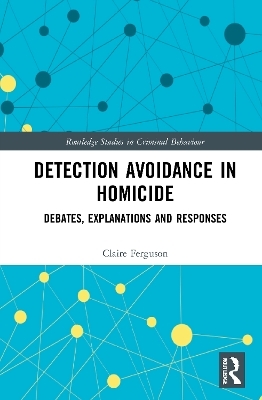
Detection Avoidance in Homicide
Routledge (Verlag)
978-0-367-26687-5 (ISBN)
From a scholarly perspective, the book presents a continuing history of research on detection avoidance by offenders, discusses the features of complex death investigations involving detection avoidance, and critiques the current frameworks used for conceptualizing these behaviors. Dr. Ferguson focuses on the key debates in the literature, argues for collaborations between researchers and practitioners to remedy siloing, and explores the reality of detection avoidance in homicides as complex and multifaceted. While detection avoidance behaviors have the potential to negatively impact sudden death investigations and frustrate criminal investigations specifically, their use also creates broader problems. These include many problematic effects on family members of the deceased, police officers, police agencies and the communities they serve. Offenders choosing to use detection avoidance behaviors challenges the efficient use of public resources, puts at risk the successful adjudication of homicides, and creates a public safety issue. The book explains detection avoidance using learning, situational, individual and gender-based theories, including proposing whether it may be a form of coercive control used by intimate partner abusers. Finally, how detection avoidance by offenders is recognized and responded to in sudden death investigations is addressed, with specific reference to useful examples of policy reform implemented by various police agencies internationally.
Providing research and theory to explain detection avoidance and best practice for responding to it, this book will be of great interest to students and scholars of criminology, forensic science and psychology. It will also be useful to professionals working with homicide offenders.
Claire Ferguson is a Senior Lecturer and researcher in the School of Justice at Queensland University of Technology in Brisbane Australia. Claire’s work bridges the gap between theory and practice in complex sudden death investigations potentially involving detection avoidance. While she has published over 40 articles in many academic journals, she also uses her research to inform training and expert consultancy for assisting police, attorneys, and coroners investigating missing persons, equivocal deaths, and suspected homicides.
1. A continuing history of research into detection avoidance
2. The basics of detection avoidance in homicide
3. Categorizing detection avoidance behavior using typologies
4. Discovering crime scene staging through deception detection
5. Explaining offenders’ use of detection avoidance
6. Towards a theory of detection avoidance as a form of coercive control
7. Challenges and opportunities in uncovering concealed homicides
Index
| Erscheinungsdatum | 22.06.2021 |
|---|---|
| Reihe/Serie | Routledge Studies in Criminal Behaviour |
| Zusatzinfo | 1 Tables, black and white; 1 Line drawings, black and white; 1 Illustrations, black and white |
| Verlagsort | London |
| Sprache | englisch |
| Maße | 156 x 234 mm |
| Gewicht | 362 g |
| Themenwelt | Geisteswissenschaften ► Psychologie |
| Recht / Steuern ► Strafrecht ► Kriminologie | |
| Sozialwissenschaften ► Soziologie | |
| ISBN-10 | 0-367-26687-3 / 0367266873 |
| ISBN-13 | 978-0-367-26687-5 / 9780367266875 |
| Zustand | Neuware |
| Haben Sie eine Frage zum Produkt? |
aus dem Bereich


